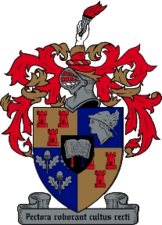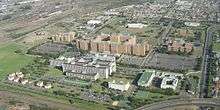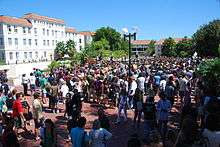Stellenbosch University
| Universiteit van Stellenbosch | |
 | |
| Motto | (Latin) Pectora roborant cultus recti |
|---|---|
Motto in English | A sound education strengthens the spirit |
| Type | Public |
| Established | 1918 |
| Endowment | R1,483.99 million[1] |
| Chancellor | Johann Rupert |
| Vice-Chancellor | Wim de Villiers |
Academic staff | 1028 [2] |
Administrative staff | 2183 [3] |
| Undergraduates | 19,042 [4] |
| Postgraduates | 10,051 [5] |
| Location | Stellenbosch, Western Cape, South Africa |
| Campus | 2 suburban and 2 urban |
| Colours | Maroon |
| Nickname | Maties |
| Mascot | Pokkel[6] |
| Affiliations | AAU, ACU, CHEC, HESA, IAU |
| Website | http://www.sun.ac.za/ |
 | |

Stellenbosch University (formally University of Stellenbosch; Afrikaans: Universiteit van Stellenbosch) is a leading public research university situated in the town of Stellenbosch, South Africa. Other nearby universities are the University of Cape Town and University of the Western Cape.
Stellenbosch University (abbreviated as SU) designed and manufactured Africa's first microsatellite, SUNSAT, launched in 1999.
Stellenbosch University was the first African university to sign the Berlin Declaration on Open Access to Knowledge in the Sciences and Humanities.[7]
The students of Stellenbosch University are nicknamed "Maties". Some claim the term arises from their maroon rugby colours: a tamatie is the Afrikaans translation for tomato. It is more likely to come from the Afrikaans colloquialism maat (meaning "buddy" or "mate") originally used diminutively by the students of the University of Cape Town's precursor, the South African College.
History
The origin of the university can be traced back to the Stellenbosch Gymnasium, which was founded in 1864 and opened on 1 March 1866. The first five students matriculated in 1870, but capacity did not initially exist for any tertiary education. However in the 1870s the Cape Colony's first locally-elected government took office and prioritised education. In 1873, four of the five 1870 matriculants became the institution's first graduates by attaining the "Second Class Certificate" through distance learning, and the gymnasium's student numbers rose to over a hundred.
In 1874, a series of government acts provided for colleges and universities, with generous subsidies and staff. A personal intervention by the Prime Minister in the same year ensured that Stellenbosch qualified, after initially being allocated to be purely a secondary school. Later in 1874, the institution acquired its first Professor and in the coming few years its capacity and staff grew rapidly. Its first academic senate was constituted at the beginning of 1876, when several new premises were also acquired. The first M.A. degree (in Stellenbosch and in South Africa) was completed in 1878, and also in that year, the Gymnasium's first four female students were enrolled.[8] [9]
The institution became the Stellenbosch College in 1881 and was located at the current Arts Department. In 1887 this college was renamed Victoria College; when it acquired university status on 2 April 1918 it was renamed once again, to Stellenbosch University. Initially only one university was planned for the Cape but after the government was visited by a delegation from the Victoria College, it was decided to allow the college to be a university if it could raise £100,000.[10]:290-1 Jannie Marais, a wealthy Stellenbosch farmer, bequeathed the money required before his death 1915.[10]:291 There were certain conditions to his gift which included Dutch/Afrikaans having equal status to English and that the lecturers teach at least half their lectures in Dutch/Afrikaans and by 1930 very little if any tuition was in English.[10]:291
In December 2014, specialists at the university performed the first successful penis transplantation, on a 21-year-old man.[11]
Name
The university uses four different forms of its name: the English versions University of Stellenbosch and Stellenbosch University, and the Afrikaans versions Universiteit van Stellenbosch and Universiteit Stellenbosch.[12][13]
Rankings
| University rankings | |
|---|---|
| Global | |
| Times[14] | 251-275 category [15] |
| QS[16] | 390 [17] |
| Africa | |
| Times[18] | 3 |
| QS[19] | 3 |
Stellenbosch University's staff and students like referring to the institution as "world class". This indicates a high sense of pride and appreciation for their university. The university is one of only three public universities in the Western Cape and one of about 20 universities in the country.
There are no existing South African or African university ranking systems, but several international rankings have ranked SU.
In the latest edition of the Times Higher Education World University Rankings, Stellenbosch University was ranked in the 251-275 category in the world and third in Africa. Another reputable ranking system, QS World University Rankings recently ranked SU at 390 in the world and also third in Africa.[17]
The Leiden University ranked SU 395th out of the top 500 universities worldwide on its CWTS Leiden Ranking list of 2013.[20] This list also ranked SU second in both South Africa and Africa, behind only the University of Cape Town.
In 2012, Webometrics ranked Stellenbosch's web footprint 2nd largest in Africa, again behind the University of Cape Town.[21]
The University of Stellenbosch Business School's MBA program was ranked 65th out of 100 MBA programmes of the leading business schools in the world the Aspen Institute’s 2011-12 edition of its Beyond Grey Pinstripes survey. The USB is also the only business school in South Africa, as well as the rest of the continent, to be included in the Top 100 list.[22]
Location

Stellenbosch, South Africa's oldest town after Cape Town, is a university town with a population of about 90,000 (excluding students). It is located about 50 kilometres from Cape Town and is situated on the banks of the Eersterivier ("First River") in the famous wine-growing region and is encircled by picturesque mountains. Teaching at Stellenbosch University is divided between the main campus in Stellenbosch, the Tygerberg campus (where the Faculty of Health Sciences is situated), the Bellville Park campus (where the University of Stellenbosch Business School (USB) is situated), and the Saldanha campus (housing the Faculty of Military Science at the Military Academy of the South African National Defence Force).
Language
Stellenbosch University is a predominantly Afrikaans-medium university, especially at the undergraduate and honours course level. However, students are allowed to write their assignments, tests and examinations in both English and Afrikaans. The language of tuition also varies depending on the faculty, with the Faculty of Arts for example being 40% English, most if not all courses are lectured bilingually and the language of most handouts or prescribed material is determined by the student.
At postgraduate level the language of tuition is determined by the composition of the class. The majority of advanced postgraduate courses are conducted in English. According to the 2008 language profile of the university, 60% of its students stated Afrikaans as their home language, 32% had English as their home language and 1.6% of students had Xhosa as their home language.[23]
The language policy is still an ongoing issue for the University, since it is one of the very few tertiary institutions left in South Africa offering tuition in Afrikaans.[24] Due to this, it is held in very high regard by the Afrikaner community, with the university even being considered a central pillar of Afrikaner life.
Student profile
Stellenbosch University's student racial profile is as follows: [25]
| Ethnic enrolment, 2015 | Percentage | Total number |
|---|---|---|
| White | 62.2% | 18,764 |
| Coloured | 17.4% | 5,238 |
| Black | 17.8% | 5,355 |
| Indian | 2.6% | 793 |
| Total | 100% | 30,150 |
Faculties and schools

Stellenbosch University consists of about 150 departments divided amongst 10 faculties. It also has more than 40 research (and other) institutions.
The faculties that are situated on the main campus are:
- Arts and Social Sciences
- Science
- Education
- AgriSciences
- Law
- Theology
- Economic and Management Sciences
- Engineering
The faculties and schools that are not situated on the main campus are:
- Military Science — situated in Saldanha Bay
- Health Sciences — situated in Tygerberg
- University of Stellenbosch Business School — situated in Bellville
The Southern African node of the Pan-African University is based in South Africa and will concentrate on space sciences.[26] This decision was connected with South Africa's bid to host the Square Kilometre Array of radio telescopes. In September 2009 Jean-Pierre Ezin, African Union commissioner for science, said the node at the University of Stellenbosch in South Africa was hoped to open in February 2010.[27] According to University World News, however, The PAU project continues in other regions although Southern Africa has been lagging behind.[28]
Facilities and services

The J.S. Gericke Library has collections scattered around the campus outside of the main facility, and all of which are catalogued on a computerised database, using the university's original mainframe, a UNIVAC. There are several other satellite libraries servicing the different faculties, including the Theology Library, Law Library and Tygerberg Medical Library.
Stellenbosch University also has a Conservatory, with two concert halls. The Conservatory is the home of the internationally acclaimed[29] Stellenbosch University Choir, who, along with being the oldest South African choir have received numerous awards overseas.[30]
The university also has a 430-seat theatre, known as the H.B. Thom Theatre and an open air amphitheatre. Accompanying these facilities is the university's own drama department, under the guidance of the Faculty of Arts and Social Sciences. The department regularly puts on plays, dramas, productions, cabarets and musicals.
The Stellenbosch University Botanical Garden is the oldest university botanical garden in South Africa.
The Langenhoven Students' Centre (Neelsie) houses the Student Representative Council, a food court, a cinema, a post office, a shopping centre, an advice office and all the student societies' offices. Student bands and various entertainment and activity promotions usually appear in the main food court during lunch hour.
The university has its own radio station known as MFM (Matie FM), situated in the Neelsie. It broadcasts over the entire Stellenbosch area at 92.6 FM. Broadcasting a mix of music, news, entertainment and campus news.
The university also distributes regular publications, Die Matie (appearing every fortnight), for its students and Kampusnuus (appearing monthly) for its staff. An official yearbook, Die Stellenbosch Student, is published annually and presented to all graduating students. Matieland is the name of the official alumni magazine. It is published twice a year and distributed to some 100 000 alumni and friends of the University.
Sport
Sports facilities for the more than 30 competitive and recreational sports that are supported by the university include two sport stadiums, two large swimming pools (one under roof), the Coetzenburg Centre, a multi-purpose center for ceremonies and indoor sports, numerous playing fields, including two artificial hockey fields, a gymnasium and a new football complex. The university offers the following sports to its students:
Stellenbosch has served as a test site in 2006 for a set of proposed modifications to the rules of rugby union, commonly referred to as the Stellenbosch Laws.
Student housing
Stellenbosch had 34 residence halls (Afrikaans: koshuise) in configurations for women only, men only and mixed gender. Each residence is supervised by a warden (koshuisvader or koshuismoeder), assisted by a House Committee of senior students. The House Committee assists students with security, maintenance, and social programs. Each residence incorporates a laundry room and a common living room. Residences for women have a communal lounge while several men's residences include a pub.
The number of available rooms in university residences is limited, which requires some students to find private boarding. Students in private lodgings can join the Private Students' Organisation (PSO), also known as Private Wards. There are 6 PSO wards, and a student is assigned according to the location of their lodgings in Stellenbosch. Students who commute to the university are assigned to one of two mixed-gender wards. As of 2008, four new PSO wards had been commissioned.
Notable alumni
- Stuart Abbott, rugby player and former economics student.
- Lourens Wepener Hugo Ackermann, former justice of the Constitutional Court of South Africa.
- Sandra Botha, former Leader of the Opposition in the National Assembly for the Democratic Alliance (South Africa).
- Edwin Cameron, Rhodes scholar and justice of the Constitutional Court of South Africa.
- Paul Cilliers, philosopher and complexity theorist.
- Danie Craven, prominent Rugby player and sport administrator.
- Riaan Cruywagen, prominent news reader and voice artist.
- Brian Currin, leading Human Rights lawyer.
- Casper de Vries, actor and comedian.
- Johan Degenaar, philosopher.
- Billy Downer, public prosecutor.
- Cromwell Everson, composer of the first Afrikaans opera.
- Alfredo Tjiurimo Hengari, political scientist.
- James Barry Munnik Hertzog, former Prime Minister of the Union of South Africa.
- Mike Horn, South African adventurer.
- Elsa Joubert, novelist.
- Uys Krige, playwright, poet and translator.
- Cornelis Jacobus Langenhoven, poet who composed words of Afrikaner anthem Die Stem.
- John Laredo, anti-apartheid campaigner.
- Daniel François Malan, former apartheid-era Prime Minister of South Africa.
- Magnus André De Merindol Malan, last Minister of defence during the Apartheid era.
- Beyers Naudé, theologian and anti-apartheid activist.
- D. C. S. Oosthuizen, (Daantjie Oosthuizen), philosopher, Christian, critic of Apartheid
- Mark Patterson, private equity investor and founder of MatlinPatterson Global Advisors
- Peet Pienaar, controversial performance artist.
- André du Pisani, political scientist and professor at University of Namibia.
- Vern Poythress, Calvinist philosopher and New Testament scholar.
- Johann Rupert, businessman and founding trustee of the Nelson Mandela Children's Fund.
- Rona Rupert, musician and author of 33 Afrikaans books.
- Johannes du Plessis Scholtz, philologist, art historian and art collector.
- Friedel Sellschop, scientist and pioneer in the field of nuclear applied physics.
- Frederik van Zyl Slabbert, former opposition politician who became chancellor of Stellenbosch University.
- James Leonard Brierley Smith, renowned ichthyologist involved with the rediscovery of the coelacanth.
- Jan Smuts, former South African Prime Minister.
- Zanne Stapelberg, opera singer.
- Sampie Terreblanche, former professor of Economics at Stellenbosch and founder member of the Democratic Party.
- Craig Tiley, CEO of Tennis Australia and Director of the Australian Open.
- Gerhard Tötemeyer, former Namibian Deputy Minister of Local and Regional Government and Housing.
- Andries Petrus Treurnicht, theologian and founder of the Conservative Party.
- Jonathan Trott, England Cricketer.
- Hendrik W. (H.W.) van der Merwe (BA 1956, MA 1957), founder of the Centre for Intergroup Studies, University of Cape Town.
- Deon van der Walt, internationally renowned opera singer.
- Attie van Heerden, Olympian, rugby union, and rugby league footballer.
- Ernst van Heerden, leading Afrikaans poet.
- Johannes Frederik Janse Van Rensburg, former leader of the Ossewabrandwag.
- Michael Ricketts, prominent molecular biology researcher and secondary school instructor.[31]
- Hendrik Frensch Verwoerd, former apartheid-era Prime Minister of South Africa.
- Balthazar Johannes Vorster, former apartheid-era Prime Minister of South Africa.
- Martin Welz, investigative journalist and editor of South African investigative magazine Noseweek.
- Heinz Winckler, entertainer and former law student.
References
- ↑ Stellenbosch University Annual Report 2011 (PDF). University of Stellenbosch. p. 83. Retrieved 21 May 2013.
- ↑ http://www.sun.ac.za/english/statistical-profile-2014-test
- ↑ http://www.sun.ac.za/english/statistical-profile-2014-test
- ↑ http://www.sun.ac.za/english/_layouts/15/WopiFrame.aspx?sourcedoc=/english/Documents/Statistics/2015/Statistiese%20Profiel%202015%20-%20Figuur%203en4.xlsx&action=default
- ↑ http://www.sun.ac.za/english/_layouts/15/WopiFrame.aspx?sourcedoc=/english/Documents/Statistics/2015/Statistiese%20Profiel%202015%20-%20Figuur%203en4.xlsx&action=default
- ↑ "Meet Pokkel the Maties mascot", Matie News, 18 February 2009
- ↑ http://hdl.handle.net/10019.1/4828
- ↑ Smuts, Francois (1979). Stellenbosch. Three Centuries. Stellenbosch: Stellenbosch Town Council & Oude Meester Group. ISBN 978-0620039215.
- ↑ Brümmer N., Smith J.J., Malherbe W.E. (1918). Gedenkboek van het Victoria-Kollege. Cape Town: Nationale Pers.
- 1 2 3 Pretorius, Fransjohan (2014). A History of South Africa: From the Distant Past to the Present Day. Hatsfield, Pretoria: Protea Book House. ISBN 978-1-86919-908-1.
- ↑ Gallagher, James (13 March 2015). "South Africans perform first 'successful' penis transplant". BBC News. Retrieved 15 March 2015.
- ↑ SUN.ac.za
- ↑ SUN.ac.za
- ↑ "World University Rankings 2015-2016". Times Higher Education. 2015. Retrieved October 1, 2015.
- ↑ "Top Universities in Africa 2011-2012". Top Universities. Times Higher Education. Retrieved 21 May 2013.
- ↑ "QS World University Rankings® 2015/16". Quacquarelli Symonds Limited. 2015. Retrieved September 18, 2015.
- 1 2 "QS World University Rankings". topuniversities.com. Retrieved 2014-11-09.
- ↑ "Top African universities". The Times Higher Education. 2012. Retrieved October 7, 2012.
- ↑ "QS World University Rankings". QS Quacquarelli Symonds Limited. 2012. Retrieved October 7, 2012.
- ↑ "CWTS Leiding Ranking 2013". Leiden University. Retrieved 21 May 2013.
- ↑ Archived 21 February 2010 at the Wayback Machine
- ↑ "MBA Degrees and Business Schools in South Africa". Mba.co.za. Retrieved 2013-03-20.
- ↑ Anthonissen, Christine (October 2008). "Language choices of English L1 learners in a Western Cape High School" (PDF). Retrieved 11 April 2011.
- ↑ Arthur Cerf (2013-08-20). "Afrique du Sud : Stellenbosch, bastion de l’ombre de l’apartheid". Le Journal International (in French). Retrieved 2015-12-20.
- ↑ "Studente inskrywings per jaar en bevolkingsgroep" (in Afrikaans). University of Stellenbosch. Retrieved 2015-12-20.
- ↑ Gilbert Nganga (4 July 2010). "Pan-African University close to starting". University World News. Retrieved 1 December 2011.
- ↑ Linda Nordling (2 September 2009). "Pan-African University could launch early next year". SciDev. Retrieved 1 December 2011.
- ↑ University World News, 22 November 2013, retrieved 3 May 2014
- ↑ "World Rankings - INTERKULTUR". interkultur.com. Retrieved 2013-03-20.
- ↑ Archived 7 December 2011 at the Wayback Machine
- ↑ Dr. Michael Ricketts at Academy for Science, Mathematics and Engineering Technologies. Retrieved January 17, 2016.
External links
| Wikimedia Commons has media related to Stellenbosch University. |
| ||||||||||||||
| ||||||||||||||||||||||||||||||||
| ||||||||||||||||||||||||||||||||||||||||||||||
| ||||||||||||||||||||||||||||||||||||||||||||||||||
Coordinates: 33°55′48.27″S 18°51′53.01″E / 33.9300750°S 18.8647250°E